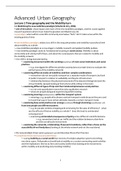Samenvatting
Samenvatting artikelen/ Summary articles Advanced Urban Geography
- Instelling
- Universiteit Utrecht (UU)
Complete en duidelijke aantekeningen van alle artikelen voor het tentamen. Samenvatting van de colleges ook te koop via dit account. De volgende artikelen zijn samengevat: College 1: Sheller, M. and J. Urry (2016), Kwan, M.P. (2013), Urry, J. (2012), Neutens, T., Schwanen, T. and F. Witlox, F. (...
[Meer zien]




